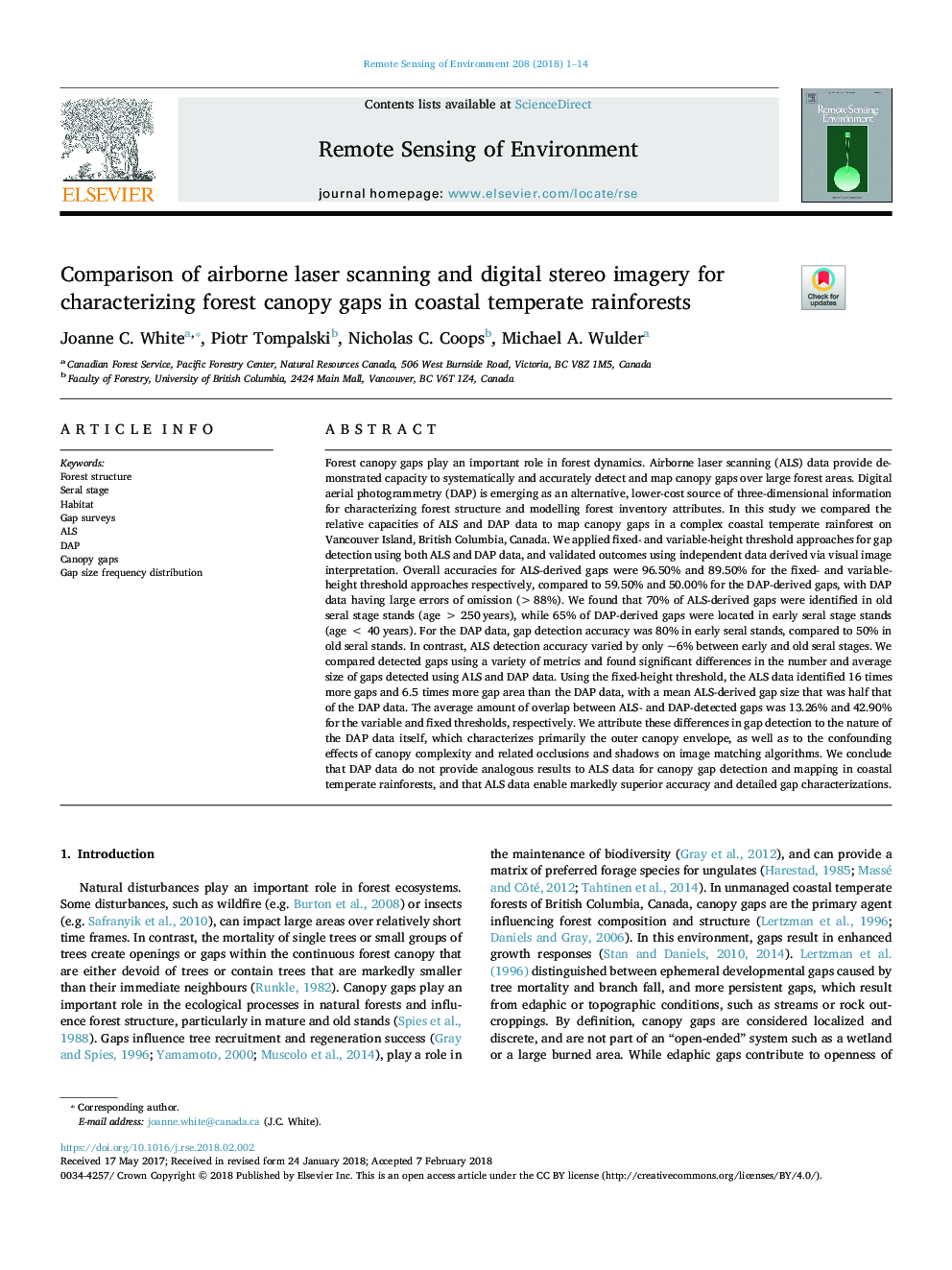| کد مقاله | کد نشریه | سال انتشار | مقاله انگلیسی | نسخه تمام متن |
|---|---|---|---|---|
| 8866688 | 1621192 | 2018 | 14 صفحه PDF | دانلود رایگان |
عنوان انگلیسی مقاله ISI
Comparison of airborne laser scanning and digital stereo imagery for characterizing forest canopy gaps in coastal temperate rainforests
ترجمه فارسی عنوان
مقایسه اسکن اسکنر هواپیما و تصاویر استریو دیجیتال برای توصیف شکاف ساقه جنگل در جنگل های بارانی معتدل ساحلی
دانلود مقاله + سفارش ترجمه
دانلود مقاله ISI انگلیسی
رایگان برای ایرانیان
کلمات کلیدی
موضوعات مرتبط
مهندسی و علوم پایه
علوم زمین و سیارات
کامپیوتر در علوم زمین
چکیده انگلیسی
Forest canopy gaps play an important role in forest dynamics. Airborne laser scanning (ALS) data provide demonstrated capacity to systematically and accurately detect and map canopy gaps over large forest areas. Digital aerial photogrammetry (DAP) is emerging as an alternative, lower-cost source of three-dimensional information for characterizing forest structure and modelling forest inventory attributes. In this study we compared the relative capacities of ALS and DAP data to map canopy gaps in a complex coastal temperate rainforest on Vancouver Island, British Columbia, Canada. We applied fixed- and variable-height threshold approaches for gap detection using both ALS and DAP data, and validated outcomes using independent data derived via visual image interpretation. Overall accuracies for ALS-derived gaps were 96.50% and 89.50% for the fixed- and variable-height threshold approaches respectively, compared to 59.50% and 50.00% for the DAP-derived gaps, with DAP data having large errors of omission (>88%). We found that 70% of ALS-derived gaps were identified in old seral stage stands (ageâ¯>â¯250â¯years), while 65% of DAP-derived gaps were located in early seral stage stands (ageâ¯<â¯40â¯years). For the DAP data, gap detection accuracy was 80% in early seral stands, compared to 50% in old seral stands. In contrast, ALS detection accuracy varied by only ~6% between early and old seral stages. We compared detected gaps using a variety of metrics and found significant differences in the number and average size of gaps detected using ALS and DAP data. Using the fixed-height threshold, the ALS data identified 16 times more gaps and 6.5 times more gap area than the DAP data, with a mean ALS-derived gap size that was half that of the DAP data. The average amount of overlap between ALS- and DAP-detected gaps was 13.26% and 42.90% for the variable and fixed thresholds, respectively. We attribute these differences in gap detection to the nature of the DAP data itself, which characterizes primarily the outer canopy envelope, as well as to the confounding effects of canopy complexity and related occlusions and shadows on image matching algorithms. We conclude that DAP data do not provide analogous results to ALS data for canopy gap detection and mapping in coastal temperate rainforests, and that ALS data enable markedly superior accuracy and detailed gap characterizations.
ناشر
Database: Elsevier - ScienceDirect (ساینس دایرکت)
Journal: Remote Sensing of Environment - Volume 208, April 2018, Pages 1-14
Journal: Remote Sensing of Environment - Volume 208, April 2018, Pages 1-14
نویسندگان
Joanne C. White, Piotr Tompalski, Nicholas C. Coops, Michael A. Wulder,
